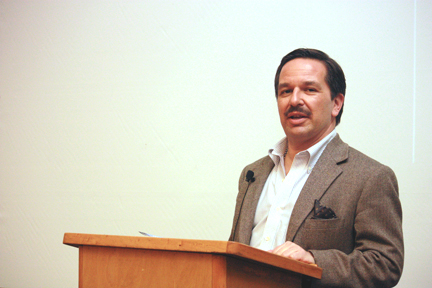Bay Area author speaks on super heroines and society
By Jessica Luthi
The Guardsman

San Francisco author Mike Madrid explored the evolution of female comic book heroes in “The Supergirls: Fashion, Feminism, Fantasy and the History of Comic Book Heroines,” a free lecture given Feb. 19. at Conlan Hall on Ocean campus.
Madrid, who authored a book with the same title of the lecture, discussed the impact comic books have on the way women are seen and the expectations of women over the past century.
“A lot of people ask me how I got interested in the subject,” he said. “And for me it started really at an early age with Supergirl. She was really captivating.”
“The Supergirls” touched on each era of comics, starting in the 30s and moving towards more modern heroines. Each decade reflected the social expectations of women during the time, using Wonder Woman as an example.
During the 30s, 40s and 50s, the female super heroes were portrayed as weak compared to their male colleagues, Madrid said.
“Even though Wonder Woman was very powerful, she still met certain resistance in her day,” he said. “In the 1940s, the Justice Society was the first team of superheroes and Wonder Woman was the female member of the team. In a lot of cases, she was a lot stronger than most of the men but was only the team’s secretary.”
The 50s were a more conservative time and comic book heroines were modeled in the same fashion. Wonder Woman was more concerned about her romantic life than fighting crime. Batwoman was called incompetent by Batman even though she was trying to help, and Lois Lane was busy showing Superman how super a wife she could be, said Madrid.
The lecture focused on pivotal moments in comic book history for super heroines and contrasted them with their predecessors as more modern comics developed.
“Storm, who was in the X-Men, was the first major black super heroine, and when she was introduced in the 70s she was sort of a disco earth goddess with weather powers,” said Madrid. “By the early 80s, she was wearing leather. She was wearing a spike collar and she had a Mohawk.”
The City College concert and lecture series committee sponsored the event and nearly 40 students attended, including City College instructor Louis Shubert’s American studies class — Comics, Society and Power which uses Madrid’s book as a required text.
“The class is an introduction to social science using comic books as our text and what we look at,” said Shubert. “After reading Mike’s book, I was like, ‘This is going to fit in perfectly. It’s about history; it’s about culture; it’s about gender.’”
The talk was approximately 50 minutes and followed by a question and answer session and book signing.
“‘The Supergirls’ was great. It’s a quick read,” sociology major Guthrie Allen said. “But I was
really sad there wasn’t an entire chapter dedicated to Wonder Woman.”
For more information on “The Supergirls” visit Madrid’s Web site www.heaven4heroes.com.
